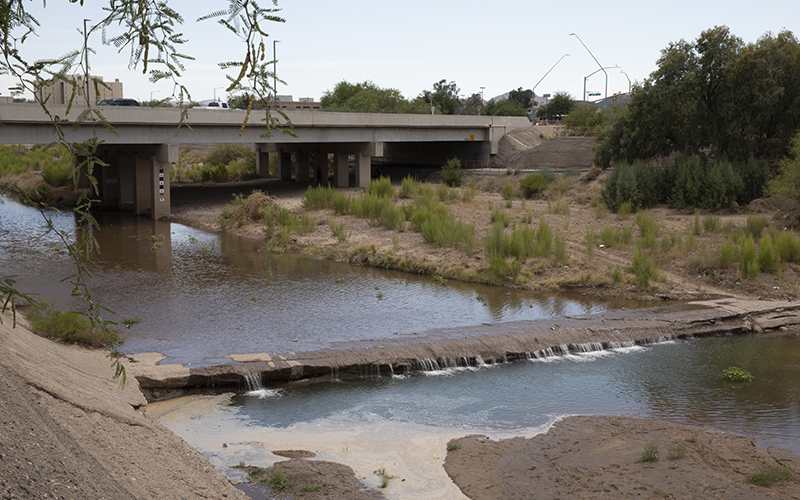
Ecologist Claire Zugmeyer joins aquatic ecologist Michael Bogan, center, and hydrologist Dick Thompson at the heritage stretch of the Santa Cruz River. (Photo by Ariana Brocious/APM)
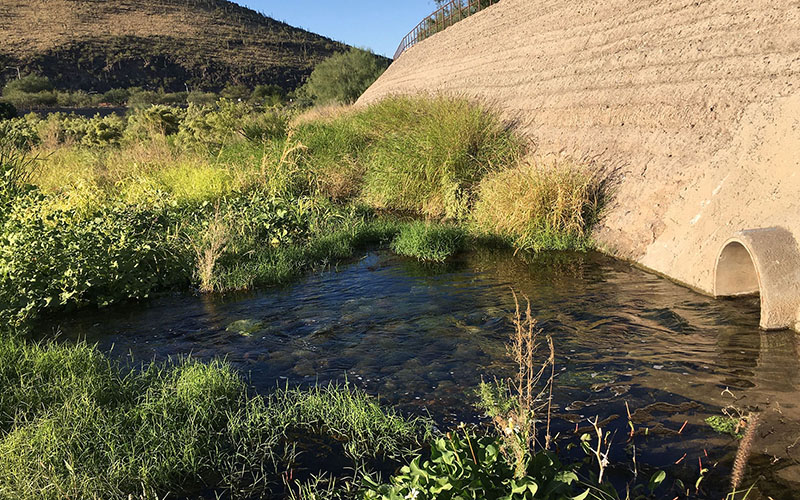
Tucson Water is putting about 1,475 gallons per minute into the stretch of the Santa Cruz River revived by the Santa Cruz River Heritage Project. (Photo by Ariana Brocious/APM)
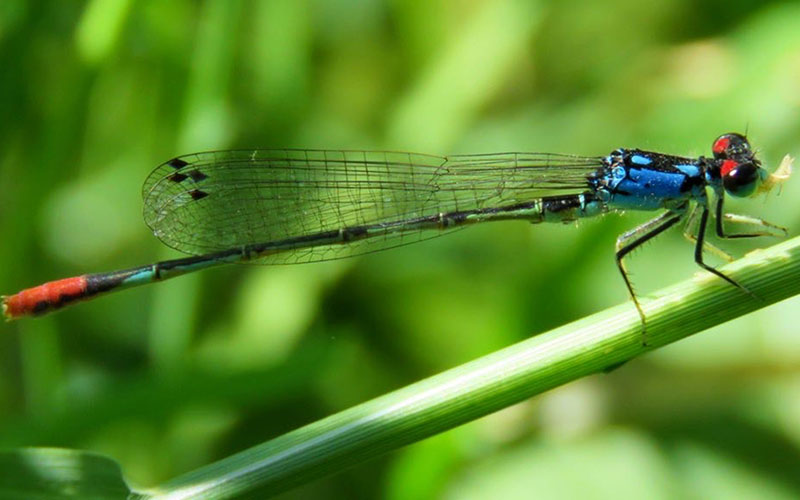
A painted damsel damselfly discovered at the heritage stretch of the Santa Cruz River in late October. (Photo courtesy of Michael Bogan)
TUCSON – Much of the Santa Cruz River is a dry, desert wash, only flowing after heavy monsoon rains. As Tucson Water hydrologist Dick Thompson and I walk along the river south of Starr Pass Boulevard, he points out how brown the vegetation looks.
“Dry as a bone,” he said.
We walk down the dry riverbed, toward the stretch of the Santa Cruz that does have water. And has it year-round.
Since June, a pipe in the side of an embankment just south of downtown has been releasing millions of gallons of treated effluent – treated wastewater – into the channel as part of the Santa Cruz River Heritage Project. As we keep walking, the vegetation changes from brown to green. Soon, we can hear, and see, a shallow, rock-bottomed pond surrounded by grassy vegetation.
We’re joined by aquatic ecologist and University of Arizona professor Michael Bogan.
“The wetland vegetation is really starting to come in here,” Bogan said, “so we see things like cattails and sedges, and this yerba manza. So it’s starting to look more like a natural cienega, or marsh.”
Bogan, who studies the north-flowing Santa Cruz, said that as soon as the water started to flow, bugs and animals started to show up, flying or hopping in from areas nearby.
“Day one, we saw seven species of dragonflies within hours of the water being released,” he said.
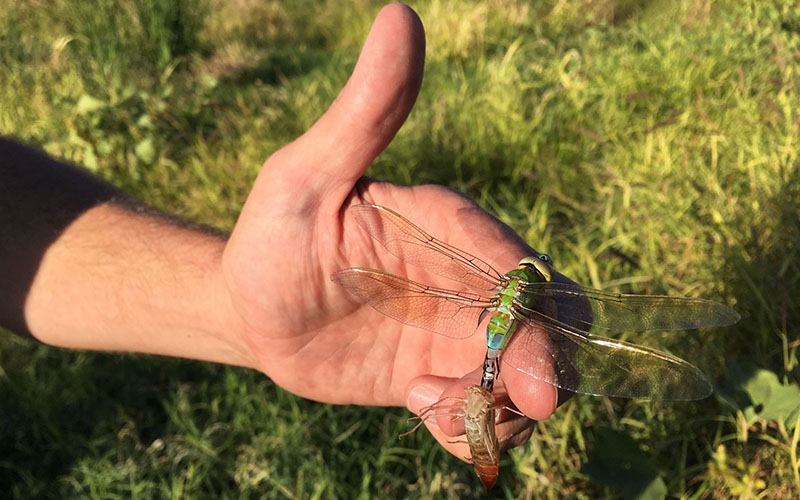
University of Arizona ecologist Michael Bogan holds a common green darner dragonfly emerging from its larval stage on a revived stretch of the Santa Cruz River. (Photo by Ariana Brocious/APM)
And more soon followed. At last count, Bogan said, 41 species of dragonflies have been seen here, which represent 80% of those native to the lower Santa Cruz River. The revival inspired the inaugural Dragonfly Day on the Santa Cruz, on Nov. 9.
It’s not just bugs, though. Toads, birds and other wildlife also visit the little oasis.
Many of those species rely on a permanent water source, which this stretch of the Santa Cruz has now become.
“The species that we’re seeing here so far are still a subset of all the species that could be here or that probably historically were here,” Bogan said. “But the river is essentially only four months old at this point, right? So that’s not a surprise.”
“This is an artificial river,” said Thompson of Tucson Water. “We’re supplementing the water that’s gone now. It used to be, over 100 years ago … there was enough rainwater and groundwater that you had intermittent flows in the Santa Cruz River, and some places stayed wet all year round. That’s all gone, due to overpumping of the aquifer.”
Thompson said the Santa Cruz revival project offers a couple benefits. First, it’s a new location for groundwater recharge. Tucson needed a new place to store treated wastewater because the city’s Sweetwater recharge basins are full. They hold 26,000 acre-feet of water, a portion of which is pumped out and replaced annually to supply clients who use the reclaimed water on golf courses and parks.
“You could think of recharge basins and the river as a bank,” Thompson said, “where you’re putting money in your bank. Some time in the future when you need that water, you can pump it back out.”
A change in law as part of the interstate drought contingency plan for the Colorado River Basin allows water utilities to get the same amount of credit for water put into a riverbed as into a recharge basin. Previously, river recharge had only earned half the credit.
Along with creating new riparian habitat, Thompson said, the other major benefit of the revival project is reconnecting people with a flowing river.
“The public gets to see it, and see how just a little bit of water makes such a profound difference,” he said. “And then when they hear about the different problems with the different watersheds around Arizona, they can think back to this and say: ‘I’ve seen that. I’ve seen what a little water does. I can’t imagine that they’re drying out other places.'”
Today, Bogan is squishing through the marshy grasses, on the hunt for damselflies.
“I think they’re all hunkered down because of the wind, but you can see them, all these little toothpicks flying around,” he said.
Ecologist Claire Zugmeyer with the Sonoran Institute said the prevalence of all these insects is directly tied to improvements Pima County Wastewater made to the quality of its treated wastewater in 2013.
“As years go on, the science and technology improves and we know how to better treat our wastewater,” she said. “So the big change that made a difference for aquatic life is the removal of ammonia and other forms of nitrogen that are very, very common in wastewater but weren’t being removed well enough before. And we’ve seen tremendous improvements in the aquatic life as a result of the improved water quality.”
Before the treatment upgrades, Zugmeyer said, the average concentration of ammonia was 20 milligrams per liter. In the 2018 water year, that had dropped to just 2 milligrams per liter – a “huge difference,” she said.
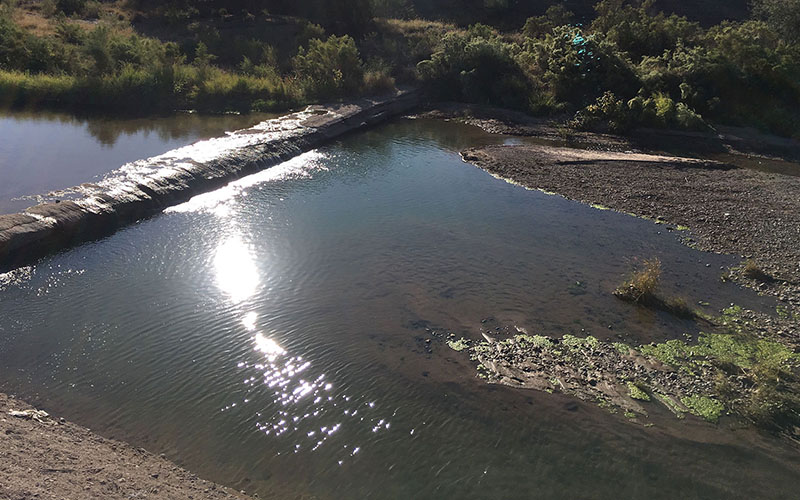
Water now flows in the Santa Cruz River from near Starr Pass/22nd Street north to Congress Street. (Photo by Ariana Brocious/APM)
Zugmeyer said the Sonoran Institute has been tracking changes and improvements on the two other effluent-fed flowing stretches of the Santa Cruz for the past decade. She’s excited about this latest stretch, even though it’s not a natural river system.
“This stretch of the river used to flow year-round,” she said, “so it has this great cultural, historical meaning, too. And even if it can’t be exactly what it was, we have a little glimpse into the past.”
After a couple minutes of searching, Bogan returns with a beautiful discovery: a common green darner dragonfly that’s still emerging from its larval skin. The colorful dragonfly is probably 3 or 4 months old, born at this riparian oasis, he said.
Thompson said Tucson Water continues to calibrate the amount of water to keep it within the bounds of the permit, which limits the flow to the Congress Street bridge. But they’re already working on phase 2 of this project, to see whether and where they might be able to add more water to the river in the next few years.
